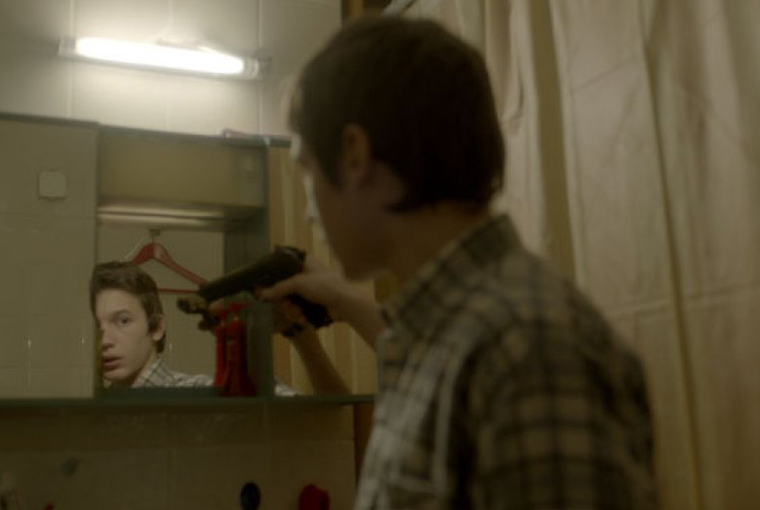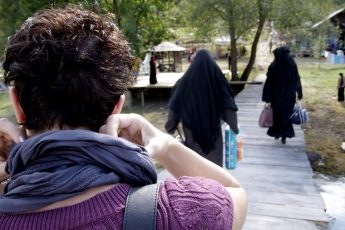
There is a story we all know. One about the war in Sarajevo, a story of death and destruction. Images of a city destroyed in a bloody conflict are still fresh in the minds of many, and in countries all over the world the end of this war was greeted with relief. We heard the stories of those who left. But what about the ones left behind? In a country still reeling from the horrors of the war the gulf between rich and poor is now large. Outsiders coming into the city don’t always acknowledge the damage it caused for those that lived through the war. It is said that no-one who hasn’t experienced war can comprehend it, but this film can help us begin to understand its bitter reality.
Aida Begić’s new film concentrates on two young people, orphans of war. Rahima (Marija Pikić) is twenty-three. She takes care of her fourteen year old brother, Nedim (Ismir Gagula), a difficult adolescent who never helps her. When a social worker comes to check out their living situation he sits stubbornly playing his computer game, refusing to answer questions or even acknowledge his sisters pleas to be polite. Each of these characters is struggling to get by. Rahima works long shifts as a chef in a restaurant: the first scene shows her carrying meat from the boot of a car into the kitchens. Holding two bloody cows’ heads, one in each hand, she remarks to her fellow chef “to be or not to be?”. Rahima is living as best she can, but she carries memories of the war close to her. She comes up against the wall of past trauma time and time again throughout the film, her expressive brown eyes telling us all we need to know. Her brother, on the other hand, is rebelling. Troubled at school, labelled an orphan and excluded from friendships, he is getting tangled in a world of crime. His sister does all she can to help him but he is ungrateful and even regrets that she removed him from the orphanage. The shoulder-held camera follows Rahima closely around the city, which we experience from her point of view, the run-down areas she frequents and the richer areas dominated by those who torment her.
Rahima wears a headscarf – a hijab. During the film, the hijab becomes a metaphor for Rahima’s struggle, a sign of her separation from other people in the past and into the present. She is the only woman in the film who wears one, even her closest female Muslim friends refraining from this sign of belief. When she talks to her younger brother about his problems at school, in one of the rare moments when he creeps out of his silence, he tells her accusingly that he never had any problems before she started wearing the hijab.
Modesty and humility are often cited as the main reasons for wearing a veil. Rahima certainly has both of these qualities. But most of all she is a warrior, a fighter. So it may be that there are other reasons for this self-stigmatisation. Make-up is often referred to as “war-paint” and there are certainly some similarities. In one revealing scene, when she approaches the father of another student from her brother’s school, she is initially dismissed as a beggar, then when she asks him a favor, and upon seeing her up close, he suggests she could pay him with her body. Unwanted sexual attention is the last thing this young woman needs. In wearing the veil, Rahima is at once closer to God and further away. Hiding from the world, she is at once protected and exposed.
Begić said that the idea for this film came to her when she realised that “we don’t believe in the reconstruction of our society any more, we’ve replaced dreams with memories”. Modern western society imagines that therapy can solve every problem, that things can be worked through and changed. But the film shows this to be false. How do you forgive the unforgivable? This is a world that has never given Rahima anything, and the end of the war has only separated those around her. Despite this, Rahima seems to have forgiven God. She wears the evidence of that on her head. But the harsh reality of the situation for orphans in Sarajevo is that it is still the memories that overshadow the dreams.
On the surface this film is about orphans growing up in difficult circumstances. The war is only mentioned a handful of times. We do know that’s why the characters are orphans, and there are some brief flashbacks to the war (in the form of real footage). The idea of war, however, is omnipresent, its heavy shadow pervading every shot. Living with that ugly sorrow is hard enough but Rahima is constantly having to defend herself: against her bosses, the high-school principal, and parents from her brothers school. The Children of Sarajevo exposes a portion of society still suffering from the war, but suffering the hardship of the current rather than the historical conflict.




Leave a Comment